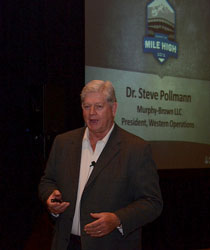When you’re the number one pork producer in the world, higher feed costs take a big bite out of the bottom line.
 At the Boehringer Ingelheim Vetmedica (BIVI) Swine Health Seminar in Denver, Dr. Steve Pollmann, President of Western Operations for Murphy-Brown, LLC shared some of his thoughts on dealing with high feed costs in commercial pig production. “We’re the live production part of Smithfield Foods,” he said. “We have about 850,000 sows located in 12 different states and we produce about 17 million pigs.
At the Boehringer Ingelheim Vetmedica (BIVI) Swine Health Seminar in Denver, Dr. Steve Pollmann, President of Western Operations for Murphy-Brown, LLC shared some of his thoughts on dealing with high feed costs in commercial pig production. “We’re the live production part of Smithfield Foods,” he said. “We have about 850,000 sows located in 12 different states and we produce about 17 million pigs.
That’s a lot of pigs to feed, so when feed costs go up, the cost of production can increase dramatically. “We all know that feed is the biggest single cost of production,” Steve said. “A 25 cent change in corn price per bushel, with that comes a $20 change in soybean price, all of the sudden you’ve got a $1.60 a hundredweight cost of production (increase).” He says the higher feed costs in the last five years or so have meant feed as a percentage of total production costs has risen from 60% to 70%.
Like all pork producers, Murphy-Brown has had to adjust to the higher feed costs by becoming more efficient. “When things get that kind of difficult, you’ve got to get better and if you don’t, you die,” he said.
Listen to my interview with Dr. Pollmann here: Dr. Steve Pollman, Murphy-Brown
